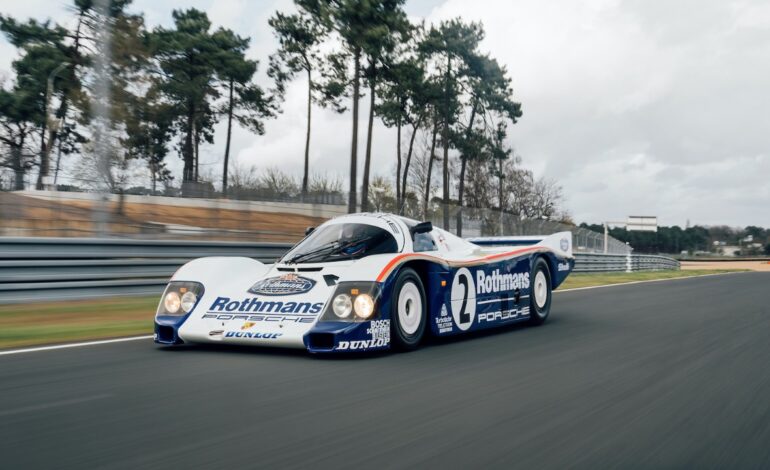Aston Martin Le Mans Return Spurs Classic Car Value Surge

Aston Martin’s return to the iconic 24 Hours of Le Mans marks a significant chapter in both motorsport and luxury investment narratives. With deep historical roots in racing and cultural touchpoints extending to British royalty and James Bond, Aston Martin’s presence at Le Mans carries the promise of prestige, performance, and profit. For collectors, investors, and fans alike, this comeback could herald more than racing glory — it may also ignite fresh momentum in the classic car market.
Founded in 1913 by Lionel Martin and Robert Bamford, Aston Martin has long represented a pinnacle of British automotive engineering and elegance. Its legacy at Le Mans is especially revered, crowned by a famous victory in 1959 with the DBR1. That same model, with only five units ever made, became a sensation in the collectors’ world decades later, fetching $22.6 million at a Sotheby’s auction in 2017.
This year, the luxury marque returns to the French endurance classic with the Valkyrie — a car built for high performance and bearing the legendary race number 007. Driven by an all-British crew comprising Harry Ticknell, Tom Gamble, and Ross Gunn, the Valkyrie symbolizes Aston Martin’s determination to reclaim its historic standing in one of the world’s most demanding races.
Le Mans 2024: An Arena of Fierce Rivalries
Aston Martin’s hopes will be tested in what is being described as one of the most competitive Le Mans fields in years. Ferrari is eyeing a rare hat trick, while Porsche is aiming for a 20th Le Mans title, a feat that would further solidify its reputation for unparalleled reliability in endurance racing.
On home soil, French manufacturers Peugeot and Alpine will be vying to break a 15-year drought — the last French win being in 2009. Mercedes makes its long-awaited return after a 25-year absence, and Jota Sport, a well-regarded British team, enters the race in partnership with Cadillac, fielding four cars. BMW and Toyota also remain strong contenders, ensuring that every hour of the 24-hour race will be intensely fought.
In this dense and dynamic mix, a victory by Aston Martin would not only be a storybook triumph but could also create a noticeable uptick in the valuation of its classic car models — especially those with racing lineage or cultural resonance.
The Allure of Aston Martin’s Classic Fleet
The power of a modern-day victory at Le Mans to elevate the profile of vintage models is not theoretical — it’s backed by decades of market behavior. The 1959 Le Mans-winning Aston Martin DBR1 remains a crown jewel of automotive investment. When one of the five units sold for $22.6 million, it wasn’t just about the car’s age or condition — it was about heritage, scarcity, and timing.
Perhaps no Aston model carries more pop culture cachet than the DB5, made famous as James Bond’s ride in Goldfinger. This association has helped the DB5 hold its value remarkably well over the years. Today, well-preserved examples can reach around $1 million. If a car with a unique history or race provenance hits the auction block, the price can surge even higher.
An even rarer gem is the 1961 DB4 GT Zagato. Only 19 of these were ever built, and one distinguished version — the ‘MP209’ — was sold at Bonhams’ Goodwood Festival of Speed auction in 2018 for £10 million. That sale marked a tenfold increase from its valuation at the turn of the millennium, making it one of the most lucrative car investments of the 21st century.
Performance Versus Portfolios: Cars Compared to Stocks
Can classic cars outperform traditional investments like the stock market? The numbers suggest they can, under the right conditions. According to the Knight Frank Luxury Investment Index, classic cars achieved a 10% average annual return from 2010 to 2020 — outpacing the S&P 500’s 7–8% return over the same period.
Individual case studies tell an even more dramatic story. A 1962 Ferrari 250 GTO, bought for $1.5 million in 1990, changed hands in 2018 for $48 million — a 30-fold return. By comparison, the S&P 500 delivered roughly a sixfold return during that time. The DB4 GT Zagato, as mentioned earlier, showed a tenfold gain since 2000, compared with the stock index’s more modest threefold rise.
Still, it’s important to remember that these gains are not universal across all models. Cars like the DB6, while respected and stylish, may not appreciate at the same rate. And unlike stocks, classic cars require significant upkeep, which eats into returns.
Maintenance, Liquidity, and the Realities of Ownership
Investing in classic cars involves more than just watching values rise. These machines require careful and often expensive upkeep. Annual costs for insurance, climate-controlled storage, and periodic restoration can range from $5,000 to $10,000. Unlike shares that can be sold with a click, a vintage car may sit on the market for months before attracting a serious buyer.
Liquidity — or the lack of it — is one of the major limitations of classic car investing. The right car might generate a large return, but finding that one buyer who shares your valuation can be a long and uncertain process.
This doesn’t mean the pursuit is ill-advised. It just means that classic car investing should be undertaken with clear eyes and realistic expectations. The appeal of owning a DB5 or DB4 Zagato goes beyond financial returns; for many, the joy of ownership is reward enough.
Rarity, Condition, and Provenance: The Three Pillars of Value
In the classic car world, three factors determine a vehicle’s investment potential: rarity, condition, and provenance. A car that is one of only a handful built will naturally command higher prices. Add excellent condition and a strong history of ownership or competition, and the car becomes even more valuable.
Condition matters enormously. Original parts, flawless bodywork, and a documented service history can all make or break a car’s valuation. Collectors are especially fond of vehicles that haven’t undergone excessive modifications or botched restorations.
Provenance — the car’s backstory — can be the single most important variable. The 1955 Mercedes-Benz 300 SLR known as the “Uhlenhaut Coupe” sold for a jaw-dropping $142 million in 2022, breaking the record for the most expensive car ever sold. The value lay not just in the model but in its uniqueness and historical narrative.
A Starting Point for New Collectors and Investors
For those new to the market, Aston Martin offers a range of potential entry points. A well-maintained DB5 might cost around $500,000, offering both investment appeal and an iconic design. Meanwhile, models like the DB7 — considered Aston Martin’s most accessible classic — can be found for about $50,000. While it may not deliver the astronomical returns of a DB4 Zagato, the DB7 offers affordability and style, making it an ideal starting point for newcomers.
It’s crucial to approach classic car collecting with passion, not just profit in mind. The experience of owning, maintaining, and driving a classic car — especially one with a storied name like Aston Martin — is rewarding in itself. A DB7 driven regularly and cherished can bring far more satisfaction than a DB6 kept in storage purely for speculation.
Potential Victory Could Redefine Future Values
If Aston Martin’s Valkyrie emerges victorious at Le Mans, it won’t just be a win for the racing team — it could send waves through the luxury car market. Past race successes have dramatically enhanced the allure of classic models from victorious brands. Ferrari’s continued dominance in racing has helped maintain strong valuations for its historic models, like the 250 GTO.
A similar outcome could unfold for Aston Martin. A modern Le Mans win would reinforce the brand’s narrative of performance, heritage, and innovation — and collectors would likely respond by reevaluating the worth of the brand’s earlier masterpieces. This ripple effect might benefit not only Aston’s most prized models but also those mid-tier classics that haven’t yet hit their full appreciation curve.
Where Passion Meets Purpose in Investment
Classic cars represent a unique blend of tangible enjoyment and financial potential. Unlike stocks, which exist as numbers on a screen, classic cars are real, beautiful objects that can be driven, displayed, and admired. They offer a connection to history, culture, and personal identity.
Aston Martin’s return to Le Mans could trigger a new wave of interest in its classic lineup — not just from investors, but from enthusiasts around the globe. While the market is complex and requires careful navigation, the rewards — both emotional and financial — can be significant.
Ultimately, classic car investment isn’t only about calculating returns. It’s about appreciating craftsmanship, reliving history, and finding joy in ownership. A well-chosen car, bought with heart and handled with care, can offer the rarest return of all — enduring value with lasting pleasure.







